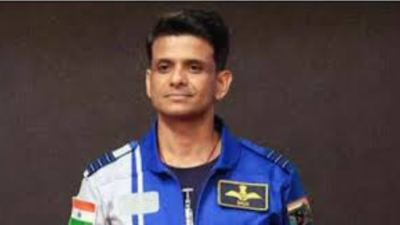ARTICLE AD BOX

India's Group Captain Shubhanshu Shukla (File Photo)
“What a ride!” That was Group Captain Shubhanshu Shukla’s first reaction from space. About 10 minutes into the flight, and about a minute after the Dragon Capsule, which has now been named “Grace”, Shukla addressed India in India.“What a ride! Namaskar mere pyare Deshvasiyo. What a ride! We’ve returned to space after 40 years and it was a fantastic ride. Right now, we are orbiting Earth at a velocity of about 7.5km/sec,” he said. “...I have my Tricolour on my shoulder which tells me that I am not alone and that I am with all of you. This is not the beginning of my journey to the ISS but the beginning of India’s human spaceflight programme. I want all Indians to be part of this journey.
All your chests must swell in pride and must be as excited. Let’s begin India’s human spaceflight journey together. Jai Hind. Jai Bharat,” he said. Before Shukla, Axiom-4 mission commander Peggy Whitson spoke. “Nominal orbital insertion and we had an incredible ride uphill and now we set our course for the International Space Station aboard the newest member of the Dragon fleet, our spacecraft named “Grace”,” she announced.
“Grace is more than a name. It reflects the elegance with which we move through space against the backdrop of Earth. It speaks to the refinement of our mission, the harmony of science and spirit and the unmerited favour we carry with humility. Grace reminds us that spaceflight is not just a feat of engineering but an act of goodwill,” she said.The other two astronauts also spoke from Grace in their native languages. Over the course of the next 24 to 28 hours, Dragon will execute a series of engine burns using its onboard thrusters.
These raise and adjust its orbit, allowing it to phase into alignment with the space station’s path.These manoeuvres are planned down to the second. Even a slight delay could affect the rendezvous window. Dragon uses GPS data, radar, and its own sensors to continuously track both its position and that of the ISS.Once Dragon is within range, it begins a slow and measured approach. It halts at several pre-set points — called waypoints — starting from 400 metres out and moving progressively closer.
At each stage, ground controllers and onboard systems assess whether to proceed.At around 20 metres, Dragon will make its final approach. Using a suite of laser-based sensors and cameras, it aligns precisely with the docking port on the station’s Harmony module. The spacecraft then moves forward at just a few centimetres per second until it makes contact.The first stage is a soft capture, where magnets gently pull the capsule into position.
This is followed by a hard capture: mechanical latches and hooks secure the spacecraft, and a pressure-tight seal is formed between Dragon and the ISS.Once docking is completed, the crew is not immediately allowed to exit their vehicle and enter the station. Engineers on the ground conduct a series of leak checks and confirm that the pressure inside the docking vestibule is stable. Once verified, the hatches between Dragon and the ISS will open.The Ax-4 astronauts then float into the space station, greeted by its current residents. Over the next two weeks, they will conduct a range of scientific experiments, including biomedical studies that could inform treatments for diseases like diabetes. For Shukla, the mission pilot, it marks not just a personal milestone but a proud moment for India’s expanding role in global space exploration.



.png)
.png)
.png)
















 3 hours ago
5
3 hours ago
5









 English (US) ·
English (US) ·